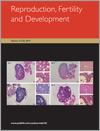Reproduction, Fertility and Development
Volume 31
Number 10 2019
The overuse of bupropion among adults has been increasing, and previous studies have reported a relationship between antidepressant use and male reproductive system dysfunction. The present study investigated the effects of paternal exposure to bupropion on offspring development. The offspring of males treated with bupropion exhibited impaired postnatal development, and the changes in the anogenital distance, vaginal opening and behaviour may be due disrupted physical development.
Cryopreservation techniques enable sperm storage for medical, commercial or conservational purposes. The objective was to study the effect of season on sperm freezability and spermatogenic activity in domestic and wild rams. Sperm cryoresistance was higher at the end of the rutting season, coinciding with testicular regression. This study contributes to the improvement of genetic resource cryobanking.
The protamine sequence of the common wombat spermatozoa was described for the first time, along with validation of a wombat sperm chromatin dispersion test. Although koala sperm nuclei show a greater incidence of chromatin swelling post-cryopreservation, thawed incubated wombat spermatozoa showed a higher incidence of DNA fragmentation. In this study, we show how differences in chromatin compactness revealed by endonuclease restriction enzymes may help to explain the variable post-thaw sperm chromatin stability in these closely related marsupials.
The precise mechanism of cryopreservation-associated loss of mammalian spermatozoa motility and fertility is not well understood. The present study revealed that sperm mitochondrial cytochrome oxidase enzyme activity and proteins undergo significant changes during cryopreservation and this might be one of the important causes of reduced fertility of cryopreserved semen. A suitable semen extender needs to be developed to minimise these changes.
Epithelial cells available in ejaculated semen can be used as nuclear donors in somatic cell nuclear transfer (SCNT) experiments. The aim of this study was to culture epithelial cells from ejaculated stored semen (for up to 6 days at 4°C) and to determine the SCNT competence of semen-derived epithelial cells. Semen-derived epithelial cells have similar SCNT competence to skin-derived fibroblast cells. The technical method described in this study can be used to culture semen-derived epithelial cells to clone breeding bulls.
Reversible male contraception remains an exciting prospect. This study demonstrated that oleanolic acid causes reversible contraception in male mice by suppressing tight-junction proteins occludin and claudin-11, thereby increasing the permeability of the testis germinal epithelium, without affecting libido. We further postulate that contraceptive reversibility is brought about by the reconstitution of the paracellular junctions between adjacent Sertoli cells.
The mechanism of polycystic ovary syndrome (PCOS) is unclear, but our findings suggest that androgen excess is the key factor in maintaining polycystic ovaries, although ovarian features may not be maintained by the metabolic disorder, which was alleviated more slowly than the former after androgen suppression. Our data highlight the importance of androgen in PCOS and of simultaneously regulating androgens and metabolism in PCOS.
This is the first report of the addition of an antioxidant during porcine cumulus–oocyte complex collection and washing. The antioxidant dimethylthiourea decreased reactive oxygen species in porcine oocytes, improved IVF efficiency and reduced cumulus apoptosis. Redox balance is key for successful embryo production. Thus, dimethylthiourea may be a tool for improving oocyte quality and embryo development.
Lipopolysaccharide (LPS) plays an important role in bacterial-induced endometritis in sows. In this study, ssc-novel-miR-106-5p reduced the LPS-induced inflammatory response in porcine endometrial epithelial cells by inhibiting the expression of the target gene MAP3K14, which explains how LPS induces endometritis. This discovery demonstrates a new means of preventing sow endometritis in the future.
Myostatin (MSTN) is known to negatively regulate skeletal muscle development but has rarely been studied in pigs. In this study we investigated muscle development in newborn heterozygous and homozygous MSTN-knockout piglets. The result showed that a lack of MSTN induces muscle hypertrophy and increases formation of fast-twitch (Type II) muscle fibers by modulating expression of myogenic differentiation factor and myocyte enhancer factor 2C in newborn piglets.
Although sex reversal is a common practice, the morphophysiological changes during sexual differentiation and testis development of genetic and sex reversal males remains poorly studied. The initial testis development and the expression of Vasa, Nanos2 and Sox9 examined in Nile tilapia did not show significant differences between control and treated groups; however, a lower expression of Sox9 and delay in sex differentiation was detected in the group treated with 17-α-methyltestosterone. These data contribute to a better understanding of the role of these proteins in testes formation and their relationship to germinative and somatic cells during initial development in fish.





